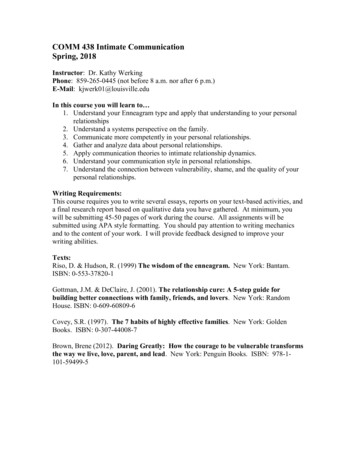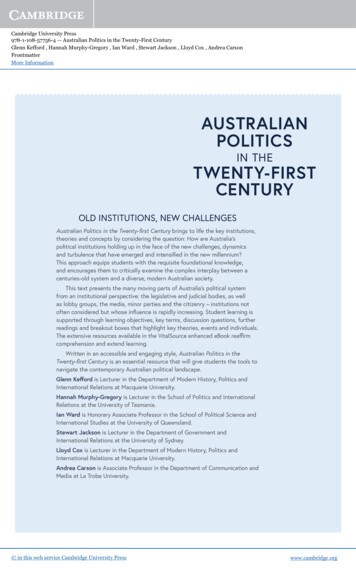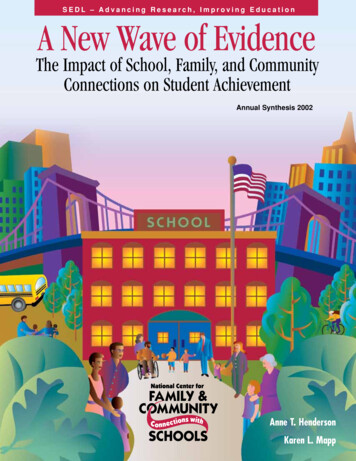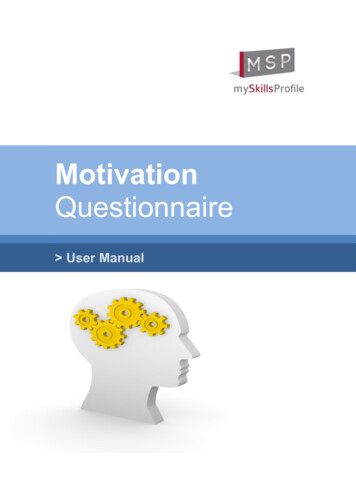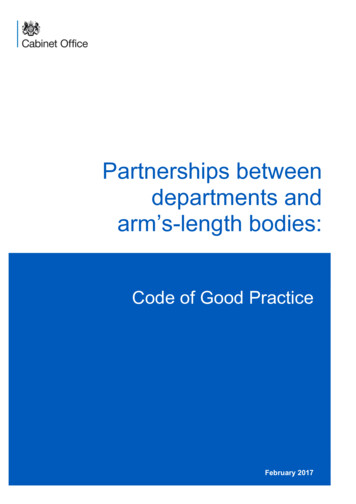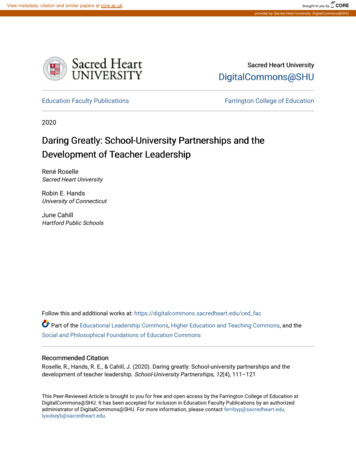
Transcription
View metadata, citation and similar papers at core.ac.ukbrought to you byCOREprovided by Sacred Heart University: DigitalCommons@SHUSacred Heart UniversityDigitalCommons@SHUEducation Faculty PublicationsFarrington College of Education2020Daring Greatly: School-University Partnerships and theDevelopment of Teacher LeadershipRené RoselleSacred Heart UniversityRobin E. HandsUniversity of ConnecticutJune CahillHartford Public SchoolsFollow this and additional works at: https://digitalcommons.sacredheart.edu/ced facPart of the Educational Leadership Commons, Higher Education and Teaching Commons, and theSocial and Philosophical Foundations of Education CommonsRecommended CitationRoselle, R., Hands, R. E., & Cahill, J. (2020). Daring greatly: School-university partnerships and thedevelopment of teacher leadership. School-University Partnerships, 12(4), 111–121This Peer-Reviewed Article is brought to you for free and open access by the Farrington College of Education atDigitalCommons@SHU. It has been accepted for inclusion in Education Faculty Publications by an authorizedadministrator of DigitalCommons@SHU. For more information, please contact ferribyp@sacredheart.edu,lysobeyb@sacredheart.edu.
Sacred Heart UniversityFrom the SelectedWorks of René RoselleWinter 2020Daring Greatly: School-University Partnershipsand the Development of Teacher LeadershipRene Roselle, Sacred Heart UniversityRobin Hands, University of ConnecticutJune Cahill, Hartford Public SchoolsAvailable at: https://works.bepress.com/rene-roselle/12/
Special IssueSchool-University Partnerships 12(4): The Impact of TeacherLeadership on Student Learning in Professional Development Schools2020Daring Greatly: School-University Partnerships and the Development of TeacherLeadershipRené Roselle, Sacred Heart UniversityRobin E. Hands, University of ConnecticutJune Cahill, Hartford Public SchoolsAbstract: This survey-based self-study explored how teachers’ commitments to a formalized leadteacher role in relationship with a university partnership impacted their perceptions of themselves aseducational leaders and as agents of change; and how these perceptions impacted P-12 studentlearning. The study showcases the importance of creating an infrastructure that includes a lead teachercomponent when establishing professional development school (PDS)-university partnerships anddemonstrates the value and impact that teacher leaders bring to partnership work. Through this study,the authors hope to further professionalize and exonerate the role of lead teacher in order to encourageothers to “dare greatly” by building on this effective model.KEYWORDS: professional development schools (PDS), teacher leadership, partnershipinfrastructure, simultaneous renewal, lead teachersNAPDS NINE ESSENTIALS ADDRESSED:2. A school–university culture committed to the preparation of future educators that embracestheir active engagement in the school community7. A structure that allows all participants a forum for ongoing governance, reflection, andcollaborate8. Work by college/university faculty and P–12 faculty in formal roles across institutionalsettingsIt is not the critic who counts; not the man who points out how the strong man stumbles, orwhere the doer of deeds could have done them better. The credit belongs to the man who isactually in the arena, whose face is marred by dust and sweat and blood; who strives valiantly;who errs, who comes short again and again, because there is no effort without error andshortcoming; but who does actually strive to do the deeds; who knows great enthusiasms, thegreat devotions; who spends himself in a worthy cause; who at the best knows in the end thetriumph of high achievement, and who at the worst, if he fails, at least fails while daring greatly. Theodore Roosevelt111
Special IssueSchool-University Partnerships 12(4): The Impact of TeacherLeadership on Student Learning in Professional Development Schools2020Teacher leaders are in the arena that Teddy Roosevelt described when giving theCitizenship in a Republic speech at the Sorbonne in Paris, France in 1910. His message includedthat a democracy needs leaders of the highest caliber in order to hold the average citizen to a highstandard. He called for leaders to engage in high integrity action and cautioned that words aloneare not enough. Today’s socio-political climate has created a need for teacher leaders to be in thearena as strong, moral, and engaged citizens more than ever before.Many definitions can be found in the literature of what constitutes a lead teacher or teacherleader (York-Barr & Duke, 2004; Wenner & Campbell, 2017). Wenner and Campbell, in theircomprehensive review of teacher leader research from 2004 to 2013, defined teacher leaders as“teachers who maintain K-12 classroom-based teaching responsibilities, while also taking onleadership responsibilities outside of the classroom” (p. 141). They go on to “acknowledge thatthis definition of teacher leadership does not represent a consensus conception but is one that helpsdifferentiate teacher leaders from other forms of leadership in schools (e.g., administrators,disciplinary specialists)” (p. 141).For decades, professional development schools (PDSs) have been discussed as a place forteacher leadership to be recognized and cultivated. Darling-Hammond, Bullmaster and Cobb(1995) described how leadership in schools “looks very different from traditional bureaucratic,hierarchical conceptions that slot individuals into different, limited functions and that place themin superordinate and subordinate relation to one another” (p. 93). Hunzicker’s (2018) more currentinterpretation of teacher leadership in professional development schools, describes it as “a strategic,process-oriented stance motivated by deep concern for students and activated through formal,informal, and hybrid leadership roles that span the boundaries of school, university, andcommunity” (p. 24). This definition illustrates the complexity of the multi-faceted roles a teacherleader plays as well as the dynamic nature of the conditions where those roles exist. Still, at theheart of a teacher leadership role is what Sergiovanni (1987) calls "cultural leadership;" the "powerto accomplish" as opposed to "power over people or events."In January of 2018, the Association of Colleges for Teacher Education (AACTE) published“A Pivot Towards Clinical Practice, Its Lexicon, and the Renewal of Teacher Education,” whichwas the culmination of years of work from experts in the field engaged in clinical practice. Thedocument outlines ten proclamations to further operationalize the recommendations of the 2010NCATE Blue Ribbon Panel report. Many of the proclamations encompass the concept of teacherleadership, but the Expertise Proclamation describes its essence best:Teaching is a profession requiring specialized knowledge and preparation. Educators arethe pedagogical and content experts. It is through the assertion and application of thisexpertise that they can inform the process and vision for renewing educator preparation.While external stakeholders play a role in the development of policies and regulations thataffect educator preparation and licensure, educators themselves must take the lead to guide,shape, and define the parameters and renewal of their profession (American Association ofColleges for Teacher Education, 2018, p. 42).Teacher leaders play essential roles in the renewal of schools, in preparing future teachers,and in supporting in-service teachers; and are often the next generation of school administrators.Studying how to identify, support, and retain this talent is imperative to the health of all schools,but especially those serving in PDSs with the charge of preparing new teachers for the profession.
Special IssueSchool-University Partnerships 12(4): The Impact of TeacherLeadership on Student Learning in Professional Development Schools2020This survey-based self-study explored how teachers’ commitments to a formalized lead teacherrole in relationship with a university partnership impacted their perceptions of themselves aseducational leaders and as agents of change; and how these perceptions impacted P-12 studentlearning.Description of the School-University PartnershipThe University of Connecticut (UConn) Neag School of Education ProfessionalDevelopment School mission is predicated on the concept of simultaneous renewal andparticipation of all stakeholders. It is important to note the distinction between the reform ofschools, a process where the emphasis is on fixing something perceived as broken, and renewal, acommitment to revisiting a system, partnership, or school many times and responding to the needsor changes of a dynamic, reciprocal relationship. Characterizing the difference between reformand renewal, Goodlad, Mantle-Bromley, and Goodlad (2004) explained, “Whereas school reformattempts to include in daily educational fare something that presumably was not there before,school renewal creates an environment – a whole culture – that routinely conducts diagnoses todetermine what is going well and what is not” (pp. 156-157). At the center of UConn’s partnershipnetwork is the commitment to simultaneous renewal.UConn’s PDS network as spanned 30 years and consists of 40 schools across nine schooldistricts with clinical faculty who hold terminal degrees overseeing the settings. The long historyof partnering has allowed time for reciprocal, trusting, professional relationships to develop amongschool and university-based educators (Fullan & Hargreaves, 1996).The purposes of this study are to showcase the importance of creating an infrastructure thatincludes a lead teacher component when establishing PDS-university partnerships and todemonstrate the value and impact that teacher leaders bring to partnership work. Additionally, wehope to further professionalize and exonerate the role of lead teacher in order to encourage othersto “dare greatly” by building on this effective model.Formalizing the Lead Teacher Role in PDSTeacher leadership capacity and potential has significant implications for school renewal,particularly in response to a national concern for educational improvement and accountability withregard to meeting the needs of all learners (Danielson, 2007; Mayrowetz, 2008; Muijs & Harris,2007; Phelps, 2008; Scribner et al., 2007; Vernon-Dotson & Floyd, 2012). University and publicschool partnerships foster collaboration that attempts to break down traditional institutional wallsso that research and practice can merge in a way that is life-giving for school and university-basededucators, P-12 students, and preservice teachers enrolled in teacher preparation programs.In 2010, University of Connecticut’s Schools as Clinics Committee (SaCC) was initiatedand co-chaired by the Director of School-University Partnerships and the Associate Director ofTeacher Education. The committee’s purpose is to provide PDS stakeholders with a forum foridentifying and discussing pertinent partnership issues, recommending policy, processingcandidate performance issues and dialoguing about the continued improvement of the teacher113
Special IssueSchool-University Partnerships 12(4): The Impact of TeacherLeadership on Student Learning in Professional Development Schools2020education program. Also discussed were ways to promote simultaneous renewal, which is theultimate goal of maintaining professional development schools.In 2013, the Schools as Clinics Committee created a formalized Lead teacher role in aneffort to professionalize and empower the role of school-based educators. This position ensuresthat communication between the university and the school is effective and ongoing. In addition tothe goal of strengthening the communication loop, the role assists in improving the quality of clinicand student teaching experiences for teacher candidates. The coalescing of this group ofprofessional educators has resulted in deeper, stronger, and more authentic relationships betweenthe lead teachers and university-based teacher educators.The lead teachers attend several meetings a year on campus with the intent of solicitingfeedback from practitioners in university teacher preparation program revisions as well aspromoting the sharing of current, best educational practices. This dynamic group has discussedtopics such as effective qualities and dispositions of cooperating teachers, gaps and strengths ofthe teacher preparation program, and high leverage teaching practices. They have reviewed andprovided feedback on the evaluations used to measure the quality and impact of field placementsas well as on observational protocols generated to focus on teacher candidate strengths and areasfor growth. Lead teachers helped create a tool to measure and assess university supervisor efficacyand have identified quality indicators of effective internship experiences for graduate students. Thework and initiatives the lead teachers have engaged in have greatly improved the overalleffectiveness of UConn’s teacher preparation program.Lead teachers hold a ten-month, annually appointed position in one of UConn’s 40partnership schools. They are nominated at the building level, using a process designed and/orendorsed by the district-level pre-service placement coordinator, and selected by their buildingadministrator based on their values of simultaneous renewal and school partnerships. Lead teachersreceive a stipend of 250.00 per semester for a total of 500.00 per academic year, which iscommensurate with the compensation offered to cooperating teachers.The roles and responsibilities of lead teacher include providing ongoing support to clinicteachers, cooperating teachers, and internship supervisors; participating in educational consortiummeetings organized by the university to engage in educational discourse and to offer apractitioner’s perspective and expertise with regard to teacher preparation; contributing to areceptacle of academic resources, such as videos, rubrics, observation protocols, and assessments,that support teacher candidates; and collaborating with university faculty in designing andexecuting research to add to the knowledge base of best educational practices, especially in theareas of the 19 Core Practices and how these practices can be leveraged to improve universitybased teacher education at the university and beyond.Examples of the type of work lead teachers engage in on a daily basis include offeringsupplemental information to clinic and cooperating teachers; observing pre-service teachercandidates; supporting problem-solving between cooperating teachers and the pre-service teachercandidates; and maintaining open lines of communication with all invested parties, includingdistrict-level personnel, school administration, university faculty, university supervisors and preservice teacher candidates.114
Special IssueSchool-University Partnerships 12(4): The Impact of TeacherLeadership on Student Learning in Professional Development Schools2020MethodologyAlthough UConn has greatly benefitted from the contributions of the lead teachers, it isalso important to understand how a university and public school partnership impacts lead teachers’perceptions of their own leadership capacity and potential. This survey-based study served as aself-study of seven teachers currently serving as lead teachers in UConn partner schools. The studywas guided by two questions: 1) What is the impact of establishing a Lead teacher componentwhen building professional development school-university partnerships? and 2) How does this roleimpact teachers’ perceptions of their leadership capacity and potential?A survey of three open-ended questions was administered to all lead teachers (n 11) inthe partnership, and seven teachers responded. The survey questions prompted lead teachers todescribe their perceptions of their leadership capacity and potential, share positive impacts of thePDS partnership on learning in their schools and classrooms; and suggest ways UConn mightcontribute to their development as teacher leaders.The survey responses were analyzed for trends and new learnings. Content analysis was theprocess used to categorize and summarize the written responses. The researchers began with opencoding, which included the initial organization of raw data in order to make sense of the writtenresponses. The analysis continued with interconnecting and linking similar responses (axialcoding), and concluded with selective coding, which allowed the researchers to formulate acohesive explanation of the responses to survey questions by connecting three identified categories,which are discussed in the next section.Discussion of FindingsTeachers’ Perceptions of LeadershipSeveral teachers noted that teacher leadership was a necessity and important foreducational improvement at all levels. The importance of teacher leadership is widely documentedin the literature as a key factor in improving schools, raising student achievement, and retainingteachers (Cosenza, 2018; Dozier, 2007).In this study, teachers felt the partnership supported collaborative work that allowed for“openly discussing, questioning and evaluating practices and pedagogy” and that their schoolcommunity and teaching has improved as a result that “could not have been accomplishedindependently.” This statement is supported by Warren and Peel (2005), as they assert that“teachers receive a greater sense of unity, greater sense of empowerment, a higher sense ofresponsibility for their school’s destiny and an increased level of pride” as a result of successfulpartnerships between schools and universities (p. 351). One teacher noted that teacher leadershipis “so important and undervalued” and appreciates that the university values her opinions as apracticing teacher.Darling-Hammond (1997) stated that “in any successful professional development process,teachers will not simply receive knowledge but also generate new knowledge about students,learning, and teaching” (p. 10). Although the Lead teacher group does not provide a formalizedprofessional development structure, it does provide both school and university-based educators115
Special IssueSchool-University Partnerships 12(4): The Impact of TeacherLeadership on Student Learning in Professional Development Schools2020opportunities to learn with and from one another, and to generate new knowledge that has a directimpact on shaping the next generation of teacher educators as well as shaping the important workof teachers in their own school districts. For example, Wenner and Campbell (2017) reported, “Asa result of participating on a leadership team in a school-university partnership school, teacherleaders in Vernon-Dotson and Floyd’s (2012) study began to take on more formal district-levelleadership roles” (p. 152).One lead teacher’s response to the survey confirmed that participation in the schooluniversity leadership team has shaped her perceptions of the importance of teacher leadership atthe district level:I think the greatest impact that this partnership has had on my perceptions of teacherleadership is the necessity for school districts to have a strong group of teacher leaders.This partnership validated and highlighted how teachers can make a positive difference intheir district through work with others. It has been great to connect with other teachersaround the state in order to hear about their experiences. I liked how we worked togethertoward a common goal but also spoke from our own perspectives.Only one teacher stated that she did not think of the lead teacher role as leadership andperceived it as more of a liaison role. She was not sure if her views have changed based on thepartnership. She added, “When I think of teacher leadership, I think of administration and learningto become an administrator.” The idea that leadership is reserved for building principals is notuncommon. Conversely, another teacher explained how the school-university partnership haschanged her perceptions of leadership by saying, “It has strengthened my idea that you do not haveto be an administrator to be an educational leader.”Beachum and Dentith (2004) and Hunzicker (2012) found that, “By and large, teacherleaders were reported to feel more confident, empowered, and professionally satisfied via theirwork as a teacher leader” (Wenner & Campbell, 2017, p. 152). This assertion was implied in thefollowing lead teacher quote: “Serving in the role of lead teacher affords staff the opportunity toimpact the learning across classrooms. Through supporting and developing the next generation ofteachers, lead teachers have a powerful role within the building.”Impact on P-12 LearningLead teachers were able to identify several ways the school-university partnershipimpacted student learning in their classrooms and school. Some of the findings were expected,such as how the partnership encourages teachers to reflect and that through making their practicetransparent, their practice improves. Another expected finding related to the presence of a secondteacher in the room and how that provides more access to instruction for students as well asdifferent ways to explain concepts. The last anticipated finding was that the partnership affords theopportunity to share new practices and ideas across settings.Interesting or unexpected findings shared by the lead teachers noted that public schoolstudents were motivated by the presence and participation of the university students to do theirbest work. Also, the teachers felt that not only did the partnership provide their students with moreopportunities to connect with a caring adult for academic support, but also for emotional support.116
Special IssueSchool-University Partnerships 12(4): The Impact of TeacherLeadership on Student Learning in Professional Development Schools2020Our understanding of the socio-emotional needs of students has become more complex, and leadteachers feel that partnering with the university can contribute to meeting more of those needs.Lead teachers found value in knowing the experiences they were providing to universitystudents may assist them in becoming more resilient in their in-service careers. Lead teachersacknowledged that the mistakes candidates are able to make under their tutelage would shape theminto gritty educators later on. These altruistic reasons for engaging in mentoring or partnershipwork have been cited in the literature (Wenner & Campbell, 2017; York-Barr & Duke, 2004).Finally, engaging in partnership work makes teaching feel less isolating for lead teachers. VernonDotson and Floyd (2012), much like Wenner and Campbell (2017), assert that “Teachers who goabove and beyond their job description of teaching in their isolated classroom encapsulate teacherleadership” (p. 40).Supporting Teacher LeadershipThese teacher leaders offer insight into ways universities can contribute to theirdevelopment as teacher leaders. This unique role affords them the opportunity to expand theirteaching role beyond the constraints of their classroom walls. Additionally, it provides a lens intothe instructional practices in various grade levels and content areas.The role of lead teacher creates an opportunity for educators to network and refine theircraft. In the words of one lead teacher:I think sometimes we get so bombarded with classroom responsibilities that we can't findthe time to research other things. Providing an opportunity for us to engage in discussionswith colleagues outside of our school setting is great for my professional development.” Inthe isolating constraints of the classroom walls, educators can often crave the opportunityto network, discuss educational trends, and debate current issues. The lead teacher role isa unique collaboration with other teachers doing leadership work across school districtsand content areas.Lead teachers report that the university can contribute to their professional growth througha continued focus on highly effective teaching strategies. Exposure to these research-basedstrategies could then be turnkeyed to their own teaching staffs, maximizing the impact acrossdistricts. Participants have also discovered the benefits of sharing common experiences. As onelead teacher stated, “I would like to have time to discuss and share experiences with othercooperating teachers. This would support my role as a cooperating teacher, ensuring I am doingall I can to support student teachers and interns.” Ultimately, teachers cited wanting more time todiscuss the work they do on a day-to-day basis.Finally, opportunities for continued teacher leadership exist through the role of lead teacher,a role that is not present in all school environments across the state. One lead teacher reported, “Iwould also, personally, hope to continue the work I have done with teaching dispositions and tocontinue to present at conferences and the partnership summit. All this work has truly strengthenedmy teaching and my capacity for leadership.” Educators who are searching for opportunities togrow professionally and are not afforded opportunities in their own school buildings can continue117
Special IssueSchool-University Partnerships 12(4): The Impact of TeacherLeadership on Student Learning in Professional Development Schools2020to build leadership potential. The following lead teacher response expresses the valuablecontribution universities can have on the development of leadership:Being the liaison for my school and the university is one of the activities that impact myown leadership capacity and potential. I am able to support student teachers and interns inthe important work of becoming certified educators, while being able to meet and formrelationships with university personnel allows me to have a voice in, as well as knowledgeof, the program that has been designed to support the creation of new educators.Compensation for the time teachers put into partnership work seems to be an issue for mostuniversities. It is widely cited in the literature that teachers are underpaid and are often asked totake on extra work for little or no additional compensation. While the lead teacher role provides a 500 stipend per year, one teacher noted that she would “love to see more compensation for thelead teachers and cooperating teachers, although [she knew] this can be a difficult task givenbudget priorities at the university.”A final interesting insight by a lead teacher noted that the best way to ensure strong futureteacher leaders was to enroll the most qualified and excellent teacher candidates into teachereducation programs. This teacher felt the likelihood that someone will become a teacher leader issomething that is apparent while they are in their pre-service careers.Implications for Practice and Next StepsThese findings provide insight in regard to furthering the capacity of UConn’s lead teachersas well as how to develop leadership capacity in all teachers. The findings also may be valuable tothose who want to start a conversation with academic deans, directors, or school administratorsregarding the value and impact lead teachers bring to partnership work and how to create aninfrastructure for the lead teacher role in PDS partnerships.Greenlee (2007) pointed out that the top-down bureaucratic structure of schools is achallenge for the development of teacher leadership capacity. Through partnership work, the fieldhas an opportunity to intentionally build leadership capacity in non-traditional ways. Teacherleadership development is not typically considered one of the goals of the PDS model; however,it is likely an unintended positive outcome. Rutter and Leon (2018) state that “layering the conceptof teacher leadership onto a professional development school (PDS) model elicits manypossibilities to enrich student learning, future teacher learning, teacher learning, and a generallyricher profession” (p. 217).Cosenza (2018) outlines several leadership roles that emerge in PDSs such ascoaching/mentoring, collaboration and sharing best practices, guest speaking, and lecturing,prestige of being a PDS, steering committee membership, and the ability to engage in reflectivepractice. Many of these roles or benefits emerged from our data. Knowing these are the waysschools and teachers perceive the benefits of PDS partnerships allows us to thoughtfully considerways to strengthen these opportunities or build them into a partnership experience.118
Special IssueSchool-University Partnerships 12(4): The Impact of TeacherLeadership on Student Learning in Professional Development Schools2020LimitationsA limitation to this study is the small sample size. Because the sample was drawn fromteachers associated with one university in one partnership model, the findings may not begeneralized. In addition, the study did not report on what teachers who do not serve in the leadteacher role might be able to offer.ConclusionBarth (2001) found that “a powerful relationship exists between learning and leading. Themost salient learning for most of us comes when we don’t know how to do it, when we want toknow how to do it, and when our responsibility for doing it will affect the lives of many others”(p. 445). Lead teachers are uniquely postured in that they are able to engage in this powerfulrelationship between learning and leading in order to have an impact on many lives. The schooluniversity partnership acts as a conduit for simultaneous inquiry among all involved (Roselle etal., 2017), which ultimately benefits all stakeholders, including school and university-basedteacher educators, P-12 students, and preservice teachers. The goal is that “both entities mustcollaborate and work together to create learning communities guided by shared beliefs aboutteaching and student learning, based on mutual trust and respect, and grounded in current evidencebased research and practitioner knowledge” (Vernon-Dotson
Roselle, R., Hands, R. E., & Cahill, J. (2020). Daring greatly: School-university partnerships and the development of teacher leadership. School-University Partnerships, 12(4), 111–121 This Peer-Reviewed Article is brought to you for free and open access by t



